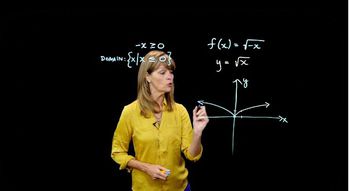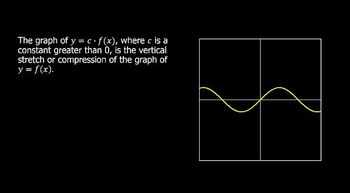Table of contents
- 0. Review of Algebra4h 16m
- 1. Equations & Inequalities3h 18m
- 2. Graphs of Equations43m
- 3. Functions2h 17m
- 4. Polynomial Functions1h 44m
- 5. Rational Functions1h 23m
- 6. Exponential & Logarithmic Functions2h 28m
- 7. Systems of Equations & Matrices4h 6m
- 8. Conic Sections2h 23m
- 9. Sequences, Series, & Induction1h 19m
- 10. Combinatorics & Probability1h 45m
3. Functions
Transformations
Problem 95b
Textbook Question
In Exercises 95-106, begin by graphing the standard cubic function, f(x) = x³. Then use transformations of this graph to graph the given function. g(x) = x³-3
 Verified step by step guidance
Verified step by step guidance1
Start by graphing the standard cubic function \( f(x) = x^3 \). This graph is a curve that passes through the origin (0,0) and has a point of inflection at the origin. It is symmetric about the origin and extends to infinity in both the positive and negative directions.
Identify the transformation needed to graph \( g(x) = x^3 - 3 \). This function is a vertical shift of the standard cubic function.
Recognize that the transformation \( x^3 - 3 \) represents a downward shift of the graph of \( x^3 \) by 3 units.
To graph \( g(x) = x^3 - 3 \), take each point on the graph of \( f(x) = x^3 \) and move it down 3 units. For example, the point (0,0) on \( f(x) \) will move to (0,-3) on \( g(x) \).
Draw the new graph of \( g(x) = x^3 - 3 \) by plotting the transformed points and ensuring the curve maintains the same shape as the original cubic function, just shifted downward.
Recommended similar problem, with video answer:
 Verified Solution
Verified SolutionThis video solution was recommended by our tutors as helpful for the problem above
Video duration:
6mPlay a video:
Was this helpful?
Key Concepts
Here are the essential concepts you must grasp in order to answer the question correctly.
Cubic Functions
A cubic function is a polynomial function of degree three, typically expressed in the form f(x) = ax³ + bx² + cx + d. The standard cubic function, f(x) = x³, has a characteristic S-shaped curve that passes through the origin and extends infinitely in both directions. Understanding the basic shape and properties of cubic functions is essential for analyzing transformations.
Recommended video:

Function Composition
Graph Transformations
Graph transformations involve shifting, reflecting, stretching, or compressing the graph of a function. For the function g(x) = x³ - 3, the '-3' indicates a vertical shift downward by three units. Recognizing how these transformations affect the original graph of f(x) = x³ is crucial for accurately graphing the new function.
Recommended video:

Intro to Transformations
Vertical Shifts
A vertical shift occurs when a constant is added to or subtracted from a function, resulting in the entire graph moving up or down. In the case of g(x) = x³ - 3, the graph of f(x) = x³ is shifted down by three units. This concept is fundamental in understanding how the position of the graph changes without altering its shape.
Recommended video:

Shifts of Functions

 5:25m
5:25mWatch next
Master Intro to Transformations with a bite sized video explanation from Nick Kaneko
Start learningRelated Videos
Related Practice
























